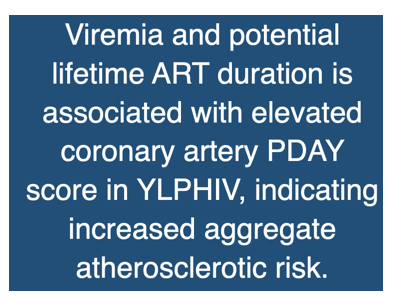| |
ESTIMATING ATHEROSCLEROTIC RISK IN SOUTH AFRICAN YOUTH WITH PERINATALLY ACQUIRED HIV
|
| |
| |
Download the PDF here
CROI 2022

Abstract Body
Youth living with perinatally acquired HIV infection (YLPHIV) may be at higher risk of atherosclerotic cardiovascular disease (CVD) due to lifetime exposure to HIV and antiretroviral therapy (ART).
We determined the Pathobiological Determinants of Atherosclerosis in Youth (PDAY) coronary arteries (CA) and abdominal aorta (AA) risk scores among YLPHIV and HIV-seronegative (HIV-) youth ?15-years of age enrolled in the Cape Town Adolescent and Antiretroviral Cohort. Components of the PDAY score included: non-high-density lipoprotein (HDL) cholesterol ?130mg/dL and HDL <40mg/dL], hyperglycemia (fasting plasma glucose ?125mg/dL), hypertension (blood pressure ?95th percentile for age, sex, and height), obesity (body mass index >30kg/m2), and cigarette smoking (>1 pack/day in the past 3 months). Socio-demographics, viremia [categorized as sustained viremia (SV) = VL>50 copies/mL, transient viremia (TV) = mix of VL >50 and ?50 copies/mL, or sustained virologic suppression (VS) = VL <50 copies/mL throughout the study], duration and type of ART were collected. Among YLPHIV, logistic regression was performed to assess factors associated with PDAY score >1 for CA and AA separately.
Overall, 219 YLPHIV and 31 HIV- youth (median age 17 years) were included. Among YLPHIV, 8% had SV, and 54% had TV. Median duration on ART was 12 years; 57% of were on a nonnucleoside reverse transcriptase inhibitor–based ART while the rest received protease inhibitor-based ART. Among YLPHIV, 28% and 13% had a CA and AA PDAY score ?1 respectively. High CA scores were attributed primarily to low levels of HDL cholesterol. Few YLPHIV met criteria for hypertension (2%, n=4) and hyperglycemia (0.5%, n=1). No HIV- youth had hypertension or hyperglycemia. More HIV- youth smoked than YLPHIV (16% vs 6%). SV [adjusted odds ratio (aOR)=15.7, p<0.01] and TV (aOR=2.4, p=0.03) compared to VS were associated with CA PDAY score >1 in YLPHIV. Duration of ART was also associated with a CA PDAY score >1 (aOR=1.1, p=0.04).
A substantial proportion of YLPHIV have PDAY scores reflecting increased aggregate atherosclerotic risk. Viremia and lifetime ART duration contribute to this risk, highlighting the importance of HIV control and monitoring cardiometabolic health as well as future studies to understand how ART impacts atherosclerotic risk in YLPHIV.
|
|
| |
| |
|
|
|